Most Significant Figures in History #3: Joseph Stalin
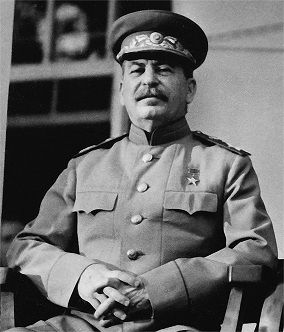
Main Facts
Joseph Vissarionovich Stalin (18 December 1878 – 5 March 1953) was a Soviet revolutionary and political leader. He governed the Soviet Union as dictator from the mid-1920s until his death in 1953, serving as Premier of the Soviet Union from 1941 to 1953 and as General Secretary of the Central Committee of the Communist Party of the Soviet Union from 1922 to 1952. Ideologically a Marxist and a Leninist, he helped to formalise these ideas as Marxism-Leninism while his own policies and theories became known as Stalinism.
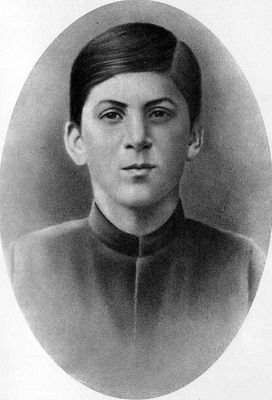
Early Life
He was the son of Vissariaon "Beso" Djugashuli and Ekaterina "Keke" Geladze; they had married in May 1872, and had lost two sons in infancy prior to Stalin's birth. They were ethnically Georgian and Stalin grew up speaking the Georgian language. Gori was then part of the Russian Empire, and was home to a population of 20,000, the majority of whom were Georgian but with Armenian, Russian, and Jewish minorities. Beso was a cobbler, and in the early years of their marriage, the couple prospered. However, he did not adapt to changing footwear fashions, and his business began to fail. The family soon found themselves living in poverty, moving through nine different rented rooms in ten years.
Beso was also an alcoholic, and drunkenly beat his wife and son. To escape the abusive relationship, Keke took Stalin and moved into the house of a family friend. Keke was determined to send her son to school, something that none of the family had previously achieved.
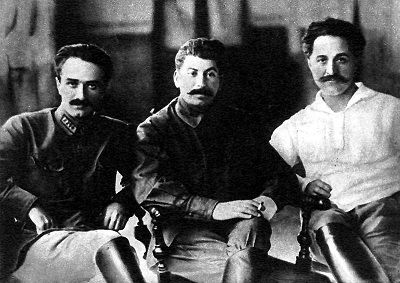
Rise to Power
Stalin played a decisive role in the 1921 Red Army invasion of Georgia, after which he adopted particularly hardline, centralist policies towards Soviet Georgia. This led to the Georgian Affair of 1922 and other incidents. Stalin's actions in Georgia created a rift with Lenin, who believed that all the Soviet states should stand equal.
Lenin nonetheless considered Stalin a loyal ally, and when he got mired in squabbles with Trotsky and other politicians, he decided to support Stalin. With the help of Lev Kamenev, Lenin appointed Stalin General Secretary in 1922. This post enabled Stalin to appoint many of his allies to government positions.
Lenin died of a stroke on 21 January 1924. Following Lenin's death, a power struggle began, which involved the following seven Politburo members: Nikolai Bukharin, Lev Kamenev, Alexei Rykov, Joseph Stalin, Mikhail Tomsky, Leon Trotsky, and Grigory Zinoviev.
Stalin pushed for more rapid industrialization and central control of the economy, contravening Lenin's New Economic Policy (NEP). At the end of 1927, a critical shortfall in grain supplies prompted Stalin to push for the collectivisation of agriculture and order the seizure of grain hoards from kulak farmers.
In December 1934, the popular Communist Party boss in Leningrad, Sergei Kirov, was murdered. Stalin blamed Kirov's murder on a vast conspiracy of saboteurs and Trotskyites. A massive purge was carried out against these internal enemies, putting them on rigged show trials and then having them executed or imprisoned in Siberian Gulags. Among these victims were old enemies, including Bukharin, Rykov, Kamenev and Zinoviev. Stalin made the loyal Nikolai Yezhov head of the secret police, the NKVD, and had him purge the NKVD of veteran Bolsheviks. With no serious opponents left in power, the purges were ended in 1938. Yezhov was held to blame for the excesses of the Great Terror. He was dismissed from office and later executed.
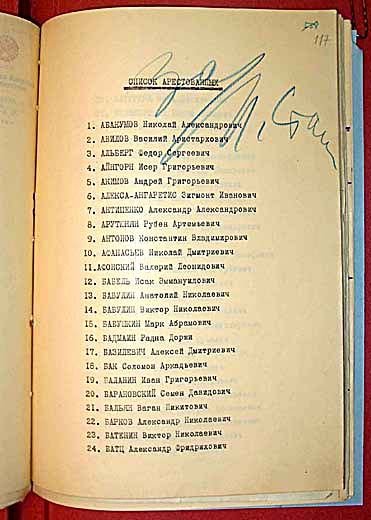
Purges and executions
In the 1930s near-absolute power was consolidated by Stalin as head of the Politburo of the Central Committee of the Communist Party of the Soviet Union, with a Great Purge of the party that was justified as an attempt to expel "opportunists" and "counter-revolutionary infiltrators". Those targeted by the purge were often expelled from the party, however more severe measures ranged from banishment to the Gulag labor camps to execution after trials held by NKVD troikas.
Stalin apparently had become increasingly worried about the growing popularity of the Leningrad party boss Sergey Kirov. At the 1934 Party Congress where the vote for the new Central Committee was held, Kirov received only three negative votes, the fewest of any candidate, while Stalin received over one hundred negative votes. After the assassination of Kirov, which may have been orchestrated by Stalin, Stalin invented a detailed scheme to implicate opposition leaders in the murder, including Trotsky, Kamenev and Zinoviev. The investigations and trials expanded. Stalin passed a new law on "terrorist organizations and terrorist acts" that were to be investigated for no more than ten days, with no prosecution, defense attorneys or appeals, followed by a sentence to be executed "quickly."
Thereafter, several trials known as the Moscow Trials were held, but the procedures were replicated throughout the country. Article 58 of the legal code, which listed prohibited anti-Soviet activities as counterrevolutionary crime, was applied in the broadest manner. Pretexts were often enough to brand someone an "enemy of the people", starting a cycle of public persecution and abuse, often proceeding to interrogation, torture and deportation, if not death. The Russian word troika gained a new meaning: a quick, simplified trial by a committee of three subordinated to NKVD—NKVD troika—with sentencing carried out within 24 hours. Stalin's hand-picked executioner, Vasily Blokhin, was entrusted with carrying out some of the high-profile executions in this period.
With the exception of Vladimir Milyutin (who died in prison in 1937) and Joseph Stalin himself, all of the members of Lenin's original cabinet who had not succumbed to death from natural causes before the purge were executed or assassinated. The purges even claimed Stalin's brothers-in-law Alexander Svanidze and Stanislav Redens.
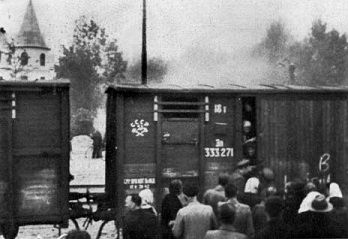
Deportations
Shortly before, during and immediately after World War II, a series of internal-population transfers were conducted on a huge scale that profoundly affected the ethnic map of the Soviet Union. It is estimated that between 1941 and 1949 nearly 3.3 million people were deported to Siberia and the Central Asian republics. Rummel estimates up to 43% of the resettled population died of diseases and malnutrition.
Ethnic groups such as the Soviet Koreans, the Volga Germans, the Crimean Tatars, the Chechens, and many Poles were moved out of strategic areas and forcibly relocated to places in the central Soviet Union, especially Kazakhstan in Soviet Central Asia. By some estimates, hundreds of thousands of deportees may have died en route.
According to official Soviet estimates, more than 14 million people passed through the Gulag from 1929 to 1953, with a further 7 to 8 million being deported and exiled to remote areas of the Soviet Union (including entire nationalities in several cases).

Collectivization
Collectivization of agriculture was carried out during the period of Stalin. This was intended to increase agricultural output from large-scale mechanized farms, to bring the peasantry under more direct political control, and to make tax collection more efficient. Collectivization brought social change on a scale not seen since the abolition of serfdom in 1861 and alienation from control of the land and its produce. The large changes also led to a drastic drop in living standards for many peasants and faced violent reaction among some of the peasantry.
In the first years of collectivization it was estimated that industrial production would rise by 200% and agricultural production by 50%. These estimations were not met. Stalin blamed this unanticipated failure on kulaks (rich peasants), who resisted collectivization. However, kulaks proper made up only 4% of the peasant population; the "kulaks" that were targeted included the slightly better-off peasants who took most of the repression from the OGPU and the Komsomol. These peasants were about 60% of the population. Those officially defined as "kulaks", "kulak helpers", and, later, "ex-kulaks" were to be executed, placed into Gulag labor camps, or deported to remote areas of the country, depending on the charge. Archival data indicates that 20,201 people were executed during 1930, the year of Dekulakization.

#World War II
Pact with Hitler
After talks with Germany regarding a potential political deal, on 23 August 1939, the Soviet Union entered into a non-aggression pact with Nazi Germany, negotiated by Soviet foreign minister Vyacheslav Molotov and German foreign minister Joachim von Ribbentrop. Officially a non-aggression treaty only, an appended secret protocol, also reached on 23 August 1939, divided eastern Europe into German and Soviet spheres of influence.
Hitler breaks the pact
In the early morning of 22 June 1941, Adolf Hitler broke the pact by implementing Operation Barbarossa, the German invasion of the Soviet Union that began the war on the Eastern Front. Already in autumn 1940 Stalin received a warning from the Dutch Communist Party, via the network of the Red Orchestra, that Hitler was preparing for a winter war by allowing the construction of thousands of snow landing gears for the Junkers Ju 52 transport planes. Although Stalin had received warnings from spies like Richard Sorge, Stalin's top spy in Imperial Japan, and his own Red Army generals, he felt that Germany would not attack the Soviet Union until Germany had defeated Britain. In the initial hours after the German attack commenced, Stalin hesitated, wanting to ensure that the German attack was sanctioned by Hitler, rather than the unauthorized action of a rogue general.

Soviets stop the Germans
In September 1941, Stalin told British diplomats that he wanted two agreements: (1) a mutual assistance/aid pact and (2) a recognition that, after the war, the Soviet Union would gain the territories in countries that it had taken pursuant to its division of Eastern Europe with Hitler in the Molotov–Ribbentrop Pact. The British agreed to assistance but refused to agree upon the territorial gains, which Stalin accepted months later as the military situation deteriorated somewhat in mid-1942. By December 1941, Hitler's troops had advanced to within 20 miles (30 km) of the Kremlin in Moscow. On 5 December, the Soviets launched a counteroffensive, pushing German troops back 40–50 miles (60–80 km) from Moscow.
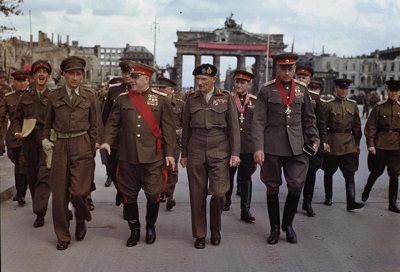
Final victory
By April 1945, Nazi Germany faced its last days with 1.9 million German soldiers in the East fighting 6.4 million Red Army soldiers while 1 million German soldiers in the West battled 4 million Western Allied soldiers. While initial talk existed of a race to Berlin by the Allies, after Stalin successfully lobbied for Eastern Germany to fall within the Soviet "sphere of influence" at Yalta, no plans were made by the Western Allies to seize the city by a ground operation.
On 30 April, Hitler and Eva Braun committed suicide, after which Soviet forces found their remains, which had been burned at Hitler's directive. German forces surrendered a few days later.
Death
Stalin's health deteriorated towards the end of World War II. He suffered from atherosclerosis from his heavy smoking, a mild stroke around the time of the Victory Parade, and a severe heart attack in October 1945.
In the early morning hours of 1 March 1953, after an all-night dinner and a movie, Stalin arrived at his Kuntsevo residence 15 km west of Moscow centre, with interior minister Lavrentiy Beria and future premiers Georgy Malenkov, Nikolai Bulganin, and Nikita Khrushchev, where he retired to his bedroom to sleep. At dawn, Stalin did not emerge from his room.
I hope you liked another article of the "Most Significant Figures in History". Note, that the number in the title does NOT mean that the one figure had more influence than the other.
Thank you for reading, I hope you liked it. If you did, consider upvoting and following me. :)
nice information sir @elephantas1
Congratulations @elephantas1! You have received a personal award!
Click on the badge to view your own Board of Honor on SteemitBoard.
For more information about this award, click here
This post has received a 16.08 % upvote from @booster thanks to: @elephantas1.